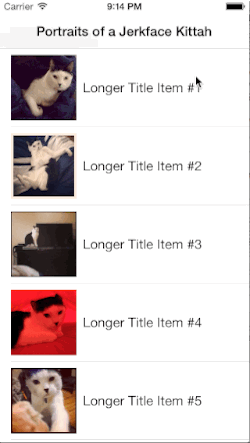DNSSwipeableTableCell 1.2.1
| TestsTested | ✗ |
| LangLanguage | Obj-CObjective C |
| License | MIT |
| ReleasedLast Release | May 2015 |
Maintained by Ellen Shapiro.
DNSSwipeableTableCell 1.2.1
- By
- Ellen Shapiro
This is an extension of a tutorial I wrote for RayWenderlich.com on how to create a swipeable UITableViewCell for iOS 7 without driving yourself completley insane with UIScrollViews. (Drive yourself insane with constraints instead!)
The crux of the problem is that while adding a delete button is super-easy, adding a delete button AND another button is a total nightmare because of the way the cells are constructed.
I've refactored the code that was included in the tutorial, which is is more meant as an exercise in helping n00bs dive into figuring out how Apple's code works under the hood, into this library, which I'm hoping will be helpful for anyone dealing with this in production code.
The Biggest Changes
- Removed dependency on the storyboard (though you can still use one if you like)
- Made the
myContentViewpublic so the cell could be subclassed and recycled more easily. - Beefed up delegate to handle an arbitrary number of buttons
- Added datasource to allow tons of user-configurable options
- Tweaked the animation so it uses spring damping instead of trying to do that manually
- Added a ton of documentation to the swipeable cell class
- Cleaned up the sample app quite a bit
- Added a sample subclass.
- Added a bunch of photos of my cat, because the internet loves cats.
Notes on Usage
- If you're using an accessory view via
accessoryType, that view will automatically be removed and replaced when the cell is opened and closed (respectively). - If you're using a custom background color for your
myContentViewalong with an accessory, remember to set that same color as the backgorund color for the cell itself, or the accessory's going to have a different background color. - If you're using a cell from a storyboard or a
.xib, you have to add amyContentViewview, and hook up theNSLayoutConstraintoutlets to the left and right constraints. See the sample project for an example of how to set this up. - If you're using a cell from a storyboard or a
.xib, make sure you're sending any calls to the superclass during setup which needmyContentViewto not benilthroughawakeFromNibinstead ofinitWithCoder:, since theIBOutletwon't be hooked up untilawakeFromNibhas fired.
//TODOs
- Support for swiping in both directions (issue)
- Support for iOS 8 style cell actions (issue)
- ??? - File an issue!
Additional Contributors
- Mark Flowers - Improved fixes for tableview slop, removed index path hack, defaults for numerous previously required methods, and better delegate methods.
Photos
All photos Copyright Ellen Shapiro. If you want to see more photos of my jerkface cat, Chaplin, follow me on Instagram.

